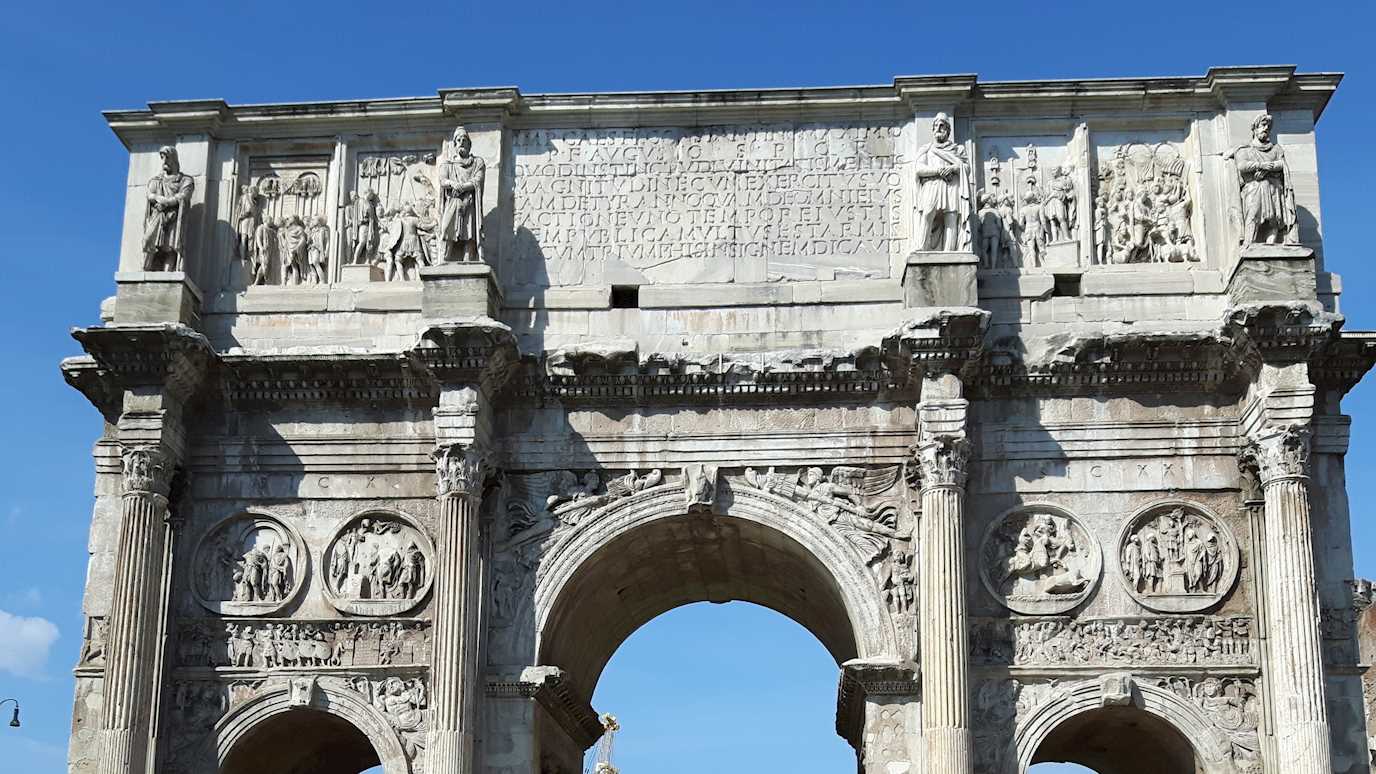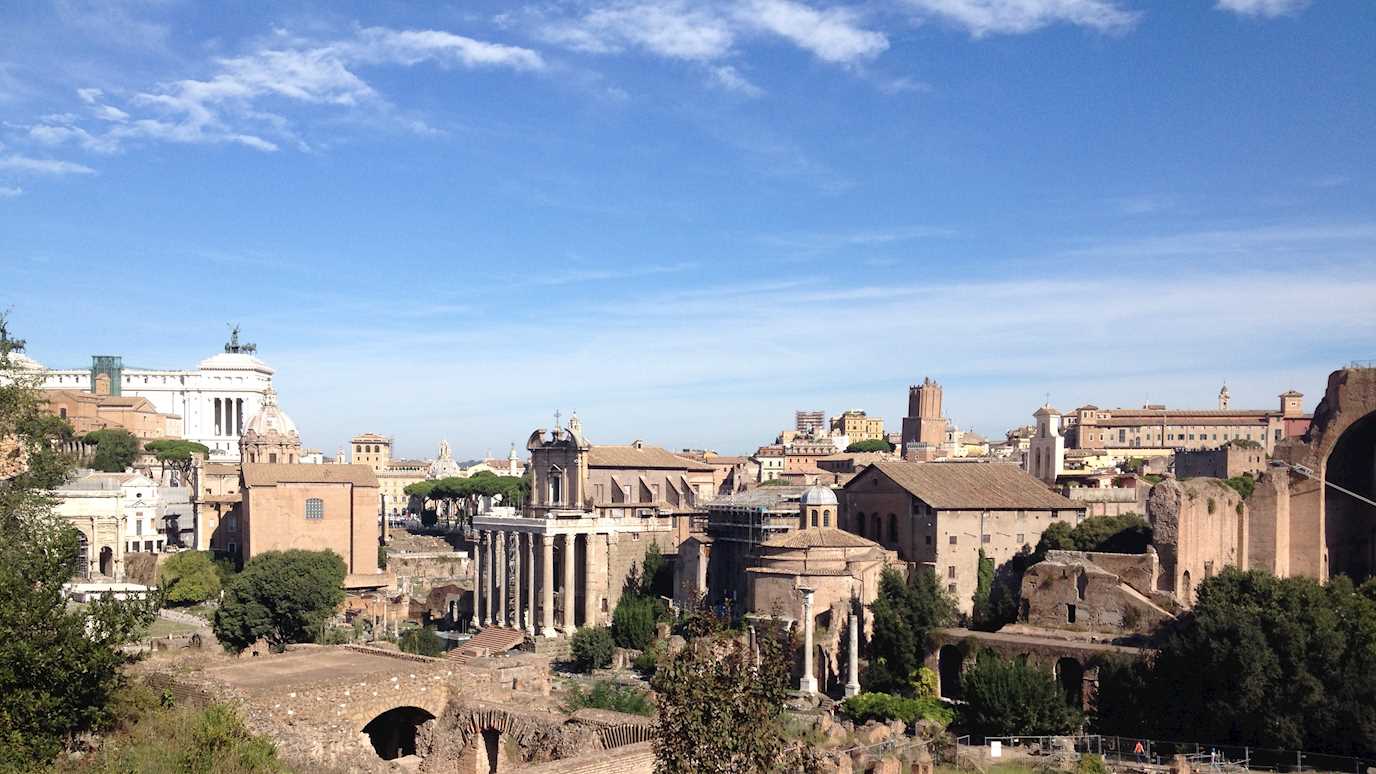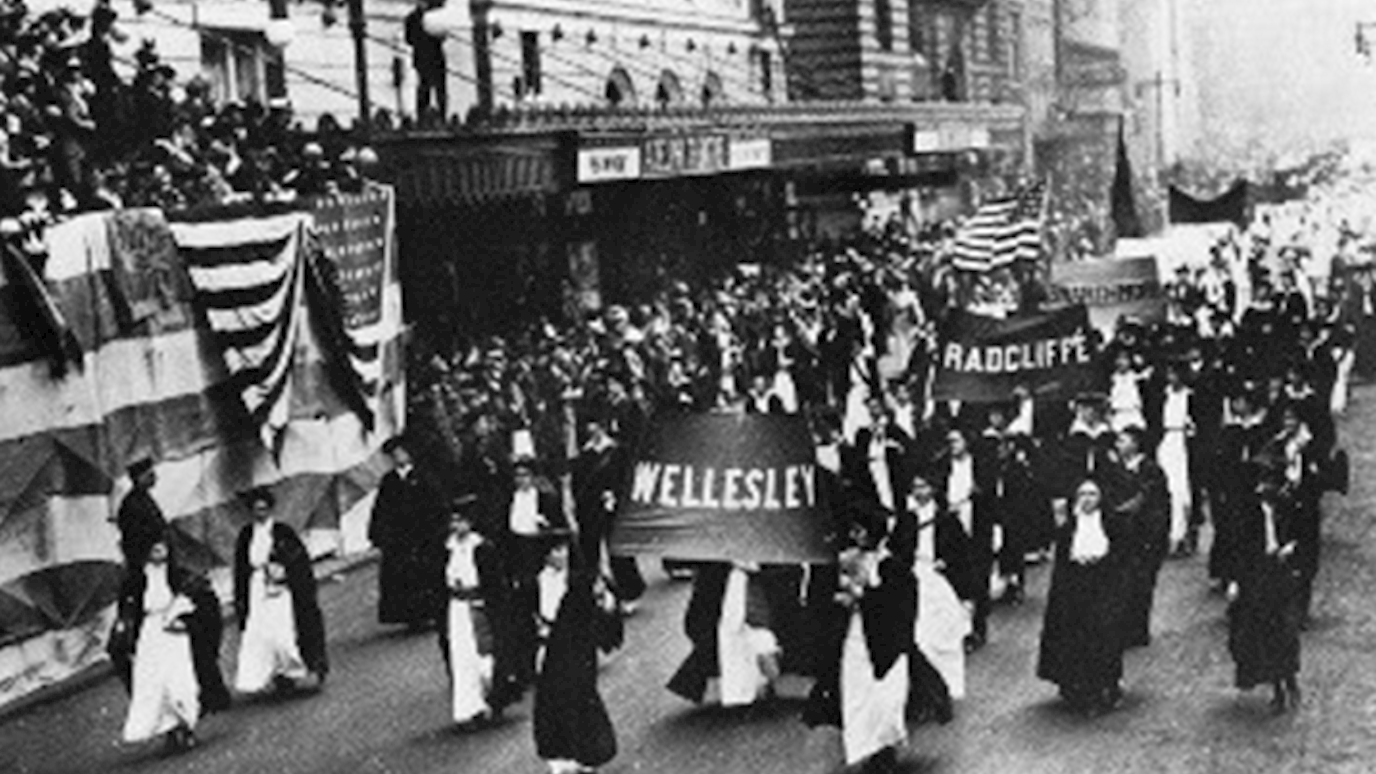The Roman History Forum co-ordinates the provision of modules in Roman History in support of programmes in History and Classics. We support students learning from introductory levels to specialist courses in the final year of your programmes, and encourage you to develop your own interests and pathways through the rich and varied field that is Roman History.
For academic year 2020-21, we will be offering the following courses:
Roman History Modules
CL1560: Key Themes in Roman History
Introductory Course
This course surveys the issues and problems in Roman History from the foundation of Rome (c. 750 BCE) to the transition to the Islamic world (c. 750 CE). In so doing, we examine the main trends in the rise and fall of Rome, from its emergence as a small city state in Central Italy to its imperial apogee when it controlled much of the Mediterranean region, the Levant and Western Europe. In so doing, we examine the inter-relationship between social and economic structures and political events, the relationship of gender to political systems, slavery, urban development and decline, and cultural change under the imperial system. We also meet many of the key characters in Roman history from Romulus to Caesar to Caligula to Constantine to Justinian and beyond. But more than anything else, this is a 'how to...' course, focused on giving you the key skills for the next stage of your journey as a Roman history
This course is available to students in the Classics Department and to students on the Ancient and Medieval History programme.
Tutor: Richard Alston
HS1105: Gods, Men and Power: An Introduction to the Ancient World from Homer to Mohammed
Year 1 course [History only: Gateway: 30 credits]
This sweeping module introduces students to the dramatic story of the ancient world, from the classical Greeks and Romans to the rise of Christianity and Islam. That story begins with Homer’s epic poems, the Iliad and Odyssey, and the emergence of the Greek city states led by the military might of Sparta and the democratic genius of Athens. The Greeks drove back the Persian empire to the east, but as the city states declined they fell under the dominion of Philip of Macedon and his son Alexander the Great. We follow Alexander’s conquests to the borders of India and back, yet his empire died with him while further west Rome was rising. The Roman Republic, with its unique constitution and marching legions, dominated the Mediterranean world only to destroy itself through ambition and civil war, until power fell into the hands of one man: Augustus, the first Roman emperor. Over the next 400 years the Roman empire spanned from Hadrian’s Wall in Britain south to the Sahara and east to the Euphrates. Within that empire a new faith emerged, venerating Jesus Christ as the Son of God, and gathered strength until the emperor Constantine converted and Christianity became the favoured imperial religion. By this time, however, the empire was facing ever greater challenges. Goths and Franks swept across western Europe, their conquests immortalised by Edward Gibbon as the “Decline and Fall of Rome”. In the east Roman power survived as the Byzantine empire centred on Constantinople. While in Arabia, the teachings of the Prophet Mohammed inspired the forces of Islam, which swept forth to redraw the map of the ancient world. Throughout this wide-ranging module, we will explore the values these societies expressed in their own words (read in translation), debate the latest scholarship, and assess the ancient legacies that shaped our modern age.
CL2363: Augustus
This is a course on ends and beginnings: the end of a Republic that had last nearly five centuries and the beginning of an Empire that was to rule much of the Mediterranean world for a further five centuries. It is a story of often extraordinary violence and brutality and the brute nature of political power. For all the fine words that historians have devoted to Augustus, violence and money lie at the heart of the regime.
Augustus sits at the centre of Roman history, a crux between Republic and Empire. Understanding Augustus forces us to ask question about the nature of Roman politics and society and especially the relationship between the two. The Augustan period is perhaps the best attested fifty years of all Roman history. We have detailed historical narrative accounts, biographies, poetry, inscriptions, and art and archaeology, all of which we need to deploy to better understand the period and the first emperor. In itself, it is a period of contradictions, a period which seems to be the start of monarchy, but which proclaims itself the restoration of the Republic, an era of conservatism startlingly innovative in art, architecture and poetry. At once, it is a moment when the power of the senators seems restored, but the people and the army are empowered. The Augustan age has claims to be totalitarian: Augustus is everywhere: in art, in literature, in politics, with the army and in the provinces. Augustus is becoming a god. Politicians of an imperial tendency have looked at Augustus as the exception, the man who saved Rome and built a new state from the ruins of the old, and seen in Augustus a justification for enlightened dictatorship. Even in the early Roman empire, Augustus was seen as an exception, the sole good emperor among so many bad. But there is a counter tale of violence and oppression and of the threat of civil war. There is a tale of Augustus as dominating and dictatorial. And there is a pile of bodies and an ocean of blood that lies behind Augustan supremacy. In the Augustan period, we have a story of power and how power becomes manifest in Roman society, reaching into all areas of that society, not just the obvious places of politics and military policy, but into the temples of the gods and the bedrooms of the elite, into the making of stories about Rome, inventing and reinventing the traditions of the city.
Tutor: Richard Alston
CL2369: Historiography of the Roman World
Perhaps the key skill of the contemporary ancient historian lies in the interpretation and understanding of ancient historiography. In this we differ fundamentally from our colleagues studying more modern periods of history. Ancient historiography was a far from simple genre. It was often stylised, containing invented speeches and dramatic interventions, literary flourishes, and echoes of prior historians. It was often inventive with the traditions of the past, borrowing stories from different periods or cultures the better to fill in ‘gaps’ in the historical account. Yet history was a serious business for the Romans; it was not an amusement or entertainment. History was an intellectual engagement with Roman politics and culture and an attempt to understand the world in which the writers lived. If, for Clausewitz ‘War is a mere continuation of policy by other means’ (Carl von Clausewitz, On War, 1918), for Romans, history was the continuation of politics by literary means: it was a way of contributing to political life through debate and argument. History-writing was a profoundly ideological act. The Romans were a historically-minded people: they looked back to the past to understand who they were and why they were and how they should act. The writing of that past was thus contentious and controversial and for the Romans, as for the totalitarians of Orwell’s Nineteen-Eighty-Four, ‘He who controls the past controls the future. He who controls the present controls the past’. Before we can understand the Roman past, we have to study the way in which the Romans tried to control that past.
Tutor: Richard Alston
HS2004: The Rise and Fall of the Roman Republic
Year 2: 15 credits [History]
The Roman Republic occupies a special place in the history of Western civilisation. From humble beginnings beside the river Tiber, the Romans expanded to dominate the classical world. Their armies defeated Carthage and the successors of Alexander the Great, and brought all the surrounding peoples under Roman rule. Yet the triumph of the Republic was also its tragedy. Political and socio-economic crisis plunged Rome into a descending spiral of civil war as rival warlords struggled for supremacy, until the Republican constitution collapsed and was replaced by the autocratic Roman empire. In this module, we explore the history of the Republic from the foundation of Rome to the murder of Julius Caesar on the Ides of March 44 BC. Students will examine the social and political pressures that drove Rome to conquer her Mediterranean empire and the consequences of that expansion for the Romans and for the peoples they conquered. The major literary sources will be discussed in translation, together with the evidence of archaeology and material culture which helps us to bring the ancient Romans to life.
HS2005: Rome and its Empire from Augustus to Commodus
Year 2: 15 credits [History]
For almost half a millennium, the Roman empire ruled over the ancient Mediterranean world. This module surveys the golden years of imperial Rome, from the achievement of sole rule by the first emperor Augustus (31 BC - AD 14) to the murder of Commodus (the white-clad emperor from Gladiator) in AD 192. At its peak, Rome’s empire spanned from Hadrian’s Wall in Britain south to North Africa and east to Syria, enclosing the Mediterranean sea within a single dominion. We will analyse the political, social and cultural developments under the emperors of the first and second centuries AD, and reassess their achievements and legacies: Claudius’ invasion of Britain, Nero’s cultured tyranny, the terrible efficiency of Domitian, Trajan the conqueror, and the philosophical Marcus Aurelius. We will likewise explore fundamental themes that shaped the wider empire, including imperial frontier policy and administration, the process of Romanisation, and the nature of Roman religion. The evidence of art and architecture will be examined, particularly the monuments from Rome herself and the wealth of material preserved in the buried town of Pompeii, alongside the major literary sources all readily available in English translation.
HS2323: Grand Designs: Art, Architecture and Power in the Roman World
Further Subject: 30 credits, year 2 [full year]
CONTACT TIME: 20 two-hour seminars (weekly)
BRIEF DESCRIPTION:
Art and architecture were key weapons in the construction of power in the Roman world and the establishment of the Empire. As Rome’s power expanded and its political system shifted towards Imperial rule, anecdotes abound as to the opulent and impressive building projects of Rome’s imperial family: thus the emperor Augustus found Rome brick and made it marble, whilst Nero’s private palace (the Domus Aurea) engulfed most of the city of Rome. Whether true or exaggerated, such tales emphasise the importance of architecture in ancient Rome and the impact and reception of building in the negotiation and contestation of power.
Using both archaeological and literary evidence, this module looks at how those in power employ art and architecture to express their authority and values. It starts with examining how artistic commissions, prestigious public buildings and art-collecting played an important role in competition between the leading politicians of the late Roman Republic. It will then move on to explore the ways in which the ultimate winner of this rivalry, the emperor Augustus, and then his successors, used art and architecture to establish and legitimise sole power and familial succession. We will consider in chronological order how images, individuals and social groups mediate and manipulate power through art and architecture.
Lecturer: Dr Hannah Platts
HS2329: Medicine in the Ancient, Medieval and Islamic World
For more details, please contact Dr Zipser
Ancient medicine was a very highly developed discipline, which had a holistic view of the patient, their life style, occupation and diet. Key to health was a perfect balance of four humours in the human body, which corresponded to the four qualities of hot, cold, wet and dry found in food, drink and the environment. Mental and physical health problems were thought to be an imbalance in these humours or qualities - our phrase "common cold" is for instance a remnant of this theory. This module will provide an introduction to the development of ancient medicine from Hippocrates to Galen, and its reception and development in the Medieval and Islamic world. It will also cover topics that are still being debated today, for instance FGM and gender reassignment surgery. A particular highlight in the session on illuminated herbals. The module also includes an employability session, in which we will explore the job market in the field of medical humanities and other associated disciplines, and also potential PG opportunities and funding.
CL3363: Augustus
This is a course on ends and beginnings: the end of a Republic that had last nearly five centuries and the beginning of an Empire that was to rule much of the Mediterranean world for a further five centuries. It is a story of often extraordinary violence and brutality and about the brute nature of political power. For all the fine words that historians have devoted to Augustus, violence and money lie at the heart of the regime.
Augustus sits at the centre of Roman history, a crux between Republic and Empire. Understanding Augustus forces us to ask question about the nature of Roman politics and society and especially the relationship between the two. The Augustan period is perhaps the best attested fifty years of all Roman history. We have detailed historical narrative accounts, biographies, poetry, inscriptions, and art and archaeology, all of which we need to deploy to better understand the period and the first emperor. In itself, it is a period of contradictions, a period which seems to be the start of monarchy, but which proclaims itself the restoration of the Republic, an era of conservatism startlingly innovative in art, architecture and poetry. At once, it is a moment when the power of the senators seems restored, but the people and the army are empowered. The Augustan age has claims to be totalitarian: Augustus is everywhere: in art, in literature, in politics, with the army and in the provinces. Augustus is becoming a god. Politicians of an imperial tendency have looked at Augustus as the exception, the man who saved Rome and built a new state from the ruins of the old, and seen in Augustus a justification for enlightened dictatorship. Even in the early Roman empire, Augustus was seen as an exception, the sole good emperor among so many bad. But there is a counter tale of violence and oppression and of the threat of civil war. There is a tale of Augustus as dominating and dictatorial. And there is a pile of bodies and an ocean of blood that lies behind Augustan supremacy. In the Augustan period, we have a story of power and how power becomes manifest in Roman society, reaching into all areas of that society, not just the obvious places of politics and military policy, but into the temples of the gods and the bedrooms of the elite, into the making of stories about Rome, inventing and reinventing the traditions of the city.
Tutor: Richard Alston
HS3523: Grand Designs: Art, Architecture and Power in the Roman World
Further Subject: 30 credits, year 3 [full year]
CONTACT TIME: 20 two-hour seminars (weekly)
BRIEF DESCRIPTION:
Art and architecture were key weapons in the construction of power in the Roman world and the establishment of the Empire. As Rome’s power expanded and its political system shifted towards Imperial rule, anecdotes abound as to the opulent and impressive building projects of Rome’s imperial family: thus the emperor Augustus found Rome brick and made it marble, whilst Nero’s private palace (the Domus Aurea) engulfed most of the city of Rome. Whether true or exaggerated, such tales emphasise the importance of architecture in ancient Rome and the impact and reception of building in the negotiation and contestation of power.
Using both archaeological and literary evidence, this module looks at how those in power employ art and architecture to express their authority and values. It starts with examining how artistic commissions, prestigious public buildings and art-collecting played an important role in competition between the leading politicians of the late Roman Republic. It will then move on to explore the ways in which the ultimate winner of this rivalry, the emperor Augustus, and then his successors, used art and architecture to establish and legitimise sole power and familial succession. We will consider in chronological order how images, individuals and social groups mediate and manipulate power through art and architecture.
Lecturer: Dr Hannah Platts
HS3296/3297: Christians and Pagans
Special Subject: 30 credits, year 3 [full year]
(Students in History are required to select the same topic and supervisor for their Special Subject and 30-credit third-year dissertation.)
This module explores the cultural revolution of the fourth century AD, when Christianity came to dominate the Mediterranean world, beginning with the accession of Constantine, the first Christian to rule the Roman Empire, in 306 and ending with the death of Augustine of Hippo, the greatest thinker to emerge from Roman Africa, in 430. Paying close attention to a wide variety of sources, from laws and inscriptions to saints’ lives, art and architecture, theology, poetry, and historical writing, we will explore the political, social and religious impact of the introduction of a new way of understanding the world. We will acquaint ourselves with a number of memorable characters: the last pagan emperor Julian ‘the Apostate’, the historian Ammianus Marcellinus, the orator Libanius, the philosopher Hypatia of Alexandria, the future saints Jerome and John Chrysostom, the Empresses Justina, Eudoxia, and Pulcheria, and the pious heiresses Olympias and Melania the Younger.
HS3529: Medicine in the Ancient, Medieval and Islamic World
For more details, please contact Dr Zipser
Ancient medicine was a very highly developed discipline, which had a holistic view of the patient, their life style, occupation and diet. Key to health was a perfect balance of four humours in the human body, which corresponded to the four qualities of hot, cold, wet and dry found in food, drink and the environment. Mental and physical health problems were thought to be an imbalance in these humours or qualities - our phrase "common cold" is for instance a remnant of this theory. This module will provide an introduction to the development of ancient medicine from Hippocrates to Galen, and its reception and development in the Medieval and Islamic world. It will also cover topics that are still being debated today, for instance FGM and gender reassignment surgery. A particular highlight in the session on illuminated herbals. The module also includes an employability session, in which we will explore the job market in the field of medical humanities and other associated disciplines, and also potential PG opportunities and funding.






















